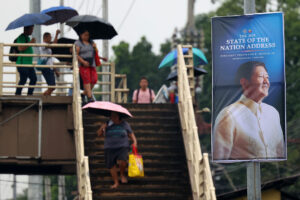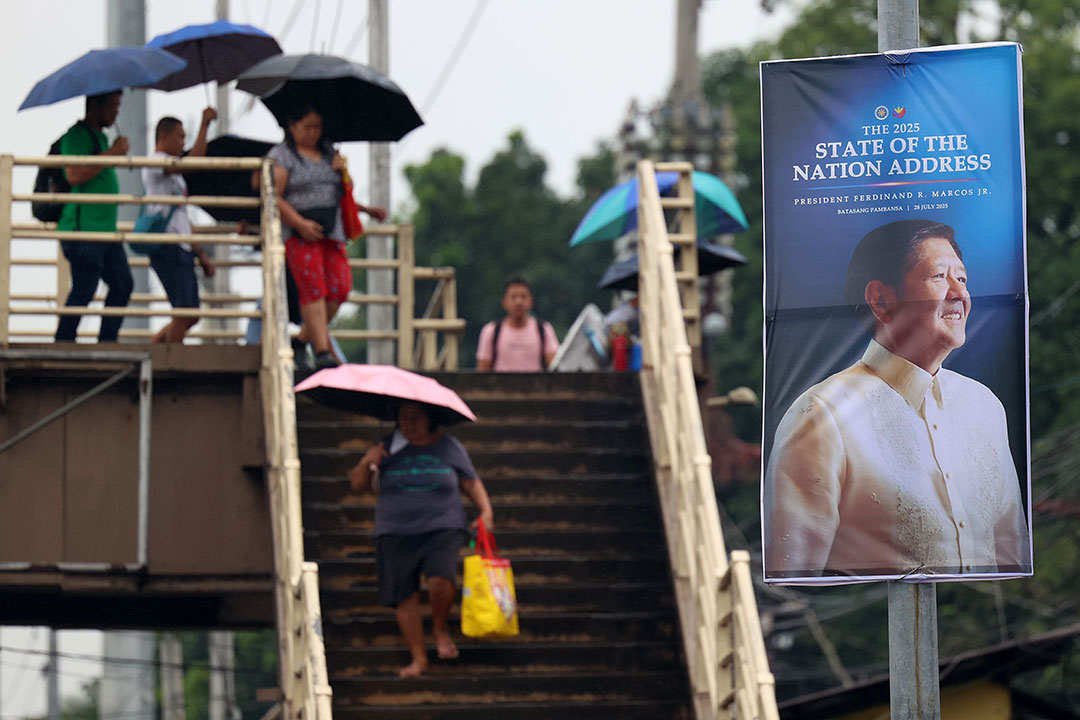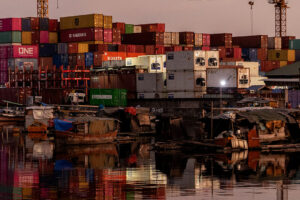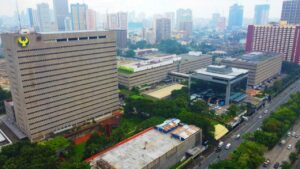
Marcos faces rising discontent as he delivers 4th SONA

By Kenneth Christiane L. Basilio, Reporter
THREE YEARS into his presidency, President Ferdinand R. Marcos, Jr. faces mounting public frustration as Filipinos say many of the promises he made during his 2022 campaign remain unfulfilled.
 As he prepares to deliver his fourth State of the Nation Address (SONA) on July 28, the disconnect between his pledges and the public’s daily experience casts a shadow over his administration’s achievements.
As he prepares to deliver his fourth State of the Nation Address (SONA) on July 28, the disconnect between his pledges and the public’s daily experience casts a shadow over his administration’s achievements.
Emmanuel V. Punzalan, a 44-year-old taxi driver, is one of many citizens who feel left behind.
“A lot of his promises remain unfulfilled, and he didn’t really do much either,” Mr. Punzalan said in Filipino, as he navigated ankle-deep floodwaters in Metro Manila.
Mr. Marcos campaigned on a platform of economic revival, promising to reduce rice prices, boost agriculture, and usher in a new industrial era. But many Filipinos like Mr. Punzalan say those ambitions have yet to trickle down to their daily lives.
Palace Press Officer Clarissa A. Castro did not respond to requests for comment.
As Mr. Marcos enters the second half of his term, political analysts say he has a critical window to enact long-term reforms that could define his legacy before the 2028 presidential election.
“The Marcos administration wants to be recognized for having fixed the economy after the storm that is the coronavirus pandemic,” Arjan P. Aguirre, a political science professor at the Ateneo de Manila University, said by telephone.
The Philippine economy shrank by a record 9.5% in 2020 amid a coronavirus pandemic. Since then, the government has ramped up borrowing, raising debt from 39.6% of gross domestic product (GDP) in 2019 to 62% in the first quarter.
Meanwhile, inflation surged in the early years of Mr. Marcos’ term, peaking at 6% in 2023. Though prices have since eased — down to 1.4% in June from 3.7% a year earlier — economic growth has slowed. GDP expanded by 5.4% in the first quarter — slower than expected — from 5.9% a year earlier.
“The Marcos administration should now pivot to attracting more foreign investors,” Reinielle Matt M. Erece, economist at Oikonomia Advisory and Research, Inc., said in a Viber message. “Expect them to focus on infrastructure development, attracting investments, and better trade agreements not just with the US but other countries as well.”
The Development Budget Coordination Committee has lowered its growth forecast to 5.5-6.5% for 2025, citing external risks such as higher tariffs imposed by the US.
After a meeting between Mr. Marcos and US President Donald J. Trump last week, the White House announced a 19% tariff on goods from the Philippines, increasing pressure on the administration to diversify export markets.
Economist Leonardo A. Lanzona of Ateneo de Manila University cited the importance of targeting industries with export potential, urging the government to craft an industrial policy that would identify priority sectors and offer incentives to attract capital.
Philippine Chamber of Commerce and Industry Chairman George T. Barcelon said the high cost of logistics continue to deter investors. “A lot of investors are concerned that our logistics cost is one of the highest in the region,” he said by telephone.
He urged reforms to improve port operations and reduce maritime costs. “We have to [cut] the logistic costs of shipping vessels, international sea liners and also the operations in the port area.”
BETTER BUSINESS ENVIRONMENTRobert M. Young, president of the Foreign Buyers Association of the Philippines, called for strengthening the Anti-Red Tape Authority (ARTA). “It seems that ARTA is lacking in teeth, it’s almost just a reporting agency,” he said by telephone.
He also pushed a national export commission to coordinate a strategic export blueprint. “The commission will create a comprehensive export plan so they can fully discharge promotion, subsidies and measures to uplift our export industry.”
Philippine exports climbed 0.8% to $34.2 billion in the five months to May, led by electronics. However, Mr. Young said local exporters don’t get enough state support including subsidies.
He asked lawmakers to further liberalize the Philippine economy by removing constitutional restrictions that hamper foreign investors.
Amid ballooning public debt, which stood at P16.92 trillion as of May, fiscal sustainability is another concern.
“We should prioritize improving tax collection efficiency and expanding the base before introducing new taxes,” John Paolo R. Rivera, a senior research fellow at the Philippine Institute for Development Studies, said in a Viber message.
The Bureau of the Treasury recently reported a P241.6-billion budget deficit in June, as spending outpaced revenue.
“We need better collection and revenue-generating schemes,” Mr. Rivera said. “The broader goal should be a fair and growth-friendly tax regime, one that does not overburden consumers or small businesses.”
He also called for pension reform, citing the ballooning cost of military pensions. “Without reform, the pension system remains fiscally unsustainable. Over time, this crowds out spending for health, education, and infrastructure.”
Mr. Rivera recommended phased contribution schemes and adjusting retirement ages to ensure the system’s longevity.
On agriculture, the Marcos administration should modernize the sector by easing access to the latest seeds and technologies, while pouring in investments directly to farmers, all of which could lead to making food cheaper, Mr. Rivera said. He also urged the government to support value-added agricultural exports to boost incomes.
POLITICAL HEADWINDSBut looming political tensions could obstruct key reforms. The May midterm elections saw Duterte-backed candidates win four of 12 Senate seats, while the Marcos slate won six — a historically weak result for an incumbent.
The President is also locked in a growing feud with Vice-President Sara Duterte-Carpio, who has declared her interest in running in 2028. Mr. Aguirre warned of “obstructionist” behavior from Duterte allies in both chambers.
“We can expect Duterte allies in the Senate, and even potential Duterte allies in the House of Representatives… to become obstructionists,” he said. “They’ll be the ones tearing down the bills being pushed by the Marcos administration.”
Ederson DT. Tapia, a political science professor at the University of Makati, said the SONA is likely to carry a message of political unity. “The first half of the Marcos administration has laid down a credible scaffolding for development, but its effects are yet to be felt by ordinary Filipinos.”
“Marcos has poured the foundation: macroeconomic stability, infrastructure and digital expansion, broader health coverage and a firmer foreign policy,” Mr. Tapia said. “But he has to convert those into felt gains in incomes, food security and political cohesion.”
As Mr. Marcos addresses the nation, citizens like Mr. Punzalan are hoping for more than rhetoric.
“He should carry out everything he vowed because that’s what the people are counting on,” he said.
Despite the frustrations, many Filipinos remain hopeful that the second half of Mr. Marcos’ term will bring the change they were promised. — with Chloe Mari A. Hufana and Adrian H. Halili




